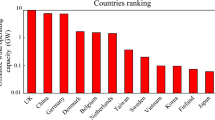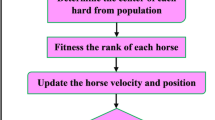Abstract
Hydrological models are widely used tools in water resources management. Their successful application requires an efficient calibration of the model parameters. Nowadays, there are very powerful global search methods applied to this end, but they have the disadvantage of presenting a high computational cost, because the numerical model to be calibrated needs to be evaluated a large number of times with different parameter sets. In this context, surrogate models can reduce significantly the run time of hydrological models, easing the total computational burden of global search methods. In the present work, we propose and explore the combination of a swarm intelligence-based optimization method, the artificial bee colony algorithm, with a surrogate model based on artificial neural networks in order to calibrate hydrological models. The proposed approach (ABC-ANN) is applied to the calibration and validation of a nine-parameter continuous hydrological model in two basins located in the northwest of Spain. Several aspects of the algorithm are evaluated, including its capability to calibrate the model parameters and its efficiency in terms of CPU time compared to a standard implementation of the ABC algorithm. Results show that the ABC-ANN algorithm is able to identify the location of suitable parameter sets with an accuracy rate within 89 and 99 %, and a reduction in CPU time of more than three orders of magnitude when compared to a sequential implementation. In addition, the frequency distribution of the parameter sets identified gives valuable information about the sensitivity of model output to the input parameters.







Similar content being viewed by others
Availability of data and materials
The meteorological data were obtained from the agency MeteoGalicia. The discharge data have been provided by the regional water administration Augas de Galicia.
References
Refsgaard JC, Storm B (1990) Construction, calibration and validation of hydrological models. In Distributed hydrological modelling, pp 41–54. Springer
Jin Xiaoli, Chong-Yu Xu, Zhang Qi, Singh VP (2010) Parameter and modeling uncertainty simulated by glue and a formal bayesian method for a conceptual hydrological model. J Hydrol 383(3–4):147–155
Yang T, Hsu K, Duan Q, Sorooshian S, Wang C (2018) Method to estimate optimal parameters. Handbook of hydrometeorological ensemble forecasting
Huo Jiuyuan, Liu Liqun (2019) Application research of multi-objective artificial bee colony optimization algorithm for parameters calibration of hydrological model. Neural Comput Appl 31(9):4715–4732
Kavetski D (2018) Parameter estimation and predictive uncertainty quantification in hydrological modelling. In Handbook of hydrometeorological ensemble forecasting, Springer
Li Zejun, Liu Pan, Deng Chao, Guo Shenglian, He Ping, Wang Caijun (2016) Evaluation of estimation of distribution algorithm to calibrate computationally intensive hydrologic model. J Hydrol Eng 21(6):04016012
Madsen H, Rosbjerg D (2006) Comparison of parameter estimation algorithms in hydrological modelling. Calibration Reliab Groundwater Model: From Uncertain Decis Making 1(304):67
Madsen Henrik (2000) Automatic calibration of a conceptual rainfall-runoff model using multiple objectives. J Hydrol 235(3–4):276–288
Holland John Henry et al (1992) Adaptation in natural and artificial systems: an introductory analysis with applications to biology, control, and artificial intelligence. MIT press, Cambridge
Wang QJ (1991) The genetic algorithm and its application to calibrating conceptual rainfall-runoff models. Water Resour Res 27(9):2467–2471
Kirkpatrick Scott (1984) Optimization by simulated annealing: quantitative studies. J Stat Phys 34(5–6):975–986
Granville Vincent, Krivánek Mirko, Rasson J-P (1994) Simulated annealing: a proof of convergence. IEEE Trans Pattern Anal Mach Intell 16(6):652–656
Duan Qingyun, Sorooshian Soroosh, Gupta Vijai (1992) Effective and efficient global optimization for conceptual rainfall-runoff models. Water Resou Res 28(4):1015–1031
Duan Qingyun, Sorooshian Soroosh, Gupta Vijai K (1994) Optimal use of the sce-ua global optimization method for calibrating watershed models. J Hydrol 158(3–4):265–284
Kennedy J, Eberhart R (1995) Particle swarm optimization. In Proceedings of ICNN’95-International Conference on Neural Networks, vol 4, pp 1942–1948. IEEE
Eberhart Russell C, Shi Yuhui, Kennedy James (2001) Swarm intelligence. Elsevier, Amsterdam
Kennedy J (2006) Swarm intelligence. In Handbook of nature-inspired and innovative computing, pp 187–219. Springer
Dorigo Marco, Birattari Mauro, Stutzle Thomas (2006) Ant colony optimization. IEEE Comput Intell Mag 1(4):28–39
Afshar Abbas, Massoumi Fariborz, Afshar Amin, Mariño Miquel A (2015) State of the art review of ant colony optimization applications in water resource management. Water Resour Manag 29(11):3891–3904
Karaboga D (2005) An idea based on honey bee swarm for numerical optimization. Technical report, Technical report-tr06, Erciyes university, engineering faculty, engineering department
Karaboga Dervis, Basturk Bahriye (2007) A powerful and efficient algorithm for numerical function optimization: artificial bee colony (abc) algorithm. J Global Optim 39(3):459–471
Razavi S, Tolson BA, Burn DH (2012) Review of surrogate modeling in water resources. Water Resour Res 48(7)
Mugunthan P, Shoemaker CA (2006) Assessing the impacts of parameter uncertainty for computationally expensive groundwater models. Water Resour Res 42(10)
Khu S-T, Savic D, Liu Y, Madsen H (2004) A fast evolutionary-based meta-modelling approach for the calibration of a rainfall-runoff model. paper presented at The First Biennial Meeting of the International Environmental Modelling Software Society, Osnabruck, Germany
Shoemaker Christine A, Regis Rommel G, Fleming Ryan C (2007) Watershed calibration using multistart local optimization and evolutionary optimization with radial basis function approximation. Hydrol Sci J 52(3):450–465
Zhang Xuesong, Srinivasan Raghavan, Van Liew Michael (2009) Approximating swat model using artificial neural network and support vector machine 1. JAWRA J Am Water Res Assoc 45(2):460–474
Bermúdez María, Cea Luis, Sopelana Javier (2019) Quantifying the role of individual flood drivers and their correlations in flooding of coastal river reaches. Stoch Environ Res Risk Assess 33(10):1851–1861
Bermúdez María, Cea Luis, Puertas Jerónimo (2019) A rapid flood inundation model for hazard mapping based on least squares support vector machine regression. J Flood Risk Manag 12:e12522
Sopelana J, Cea L, Ruano S (2018) A continuous simulation approach for the estimation of extreme flood inundation in coastal river reaches affected by meso-and macrotides. Natural Hazards 93(3):1337–1358
Shrestha DL, Kayastha N, Solomatine DP (2009) A novel approach to parameter uncertainty analysis of hydrological models using neural networks. Hydrol Earth Syst Sci 13(7):1235–1248
Liong Shie-Yui, Khu Soon-Thiam, Chan Weng-Tat (2001) Derivation of pareto front with genetic algorithm and neural network. J Hydrol Eng 6(1):52–61
Huo Jiuyuan, Liu Liqun, Zhang Yaonan (2016) Comparative research of optimization algorithms for parameters calibration of watershed hydrological model. J Comput Methods Sci Eng 16(3):653–669
Okkan U, GedïK N (2018) Evaluation of population based evolutionary optimization algorithms in the conceptual hydrological model calibration. In Gastescu, P., Bretcan, P.(edit, 2018), Water resources and wetlands, 4th International Conference Water resources and wetlands, pp 5–9
Anılan Tuğçe, Uzlu Ergun, Kankal Murat, Yuksek Omer (2018) The estimation of flood quantiles in ungauged sites using teaching-learning based optimization and artificial bee colony algorithms. Scientia Iranica 25(2):632–645
Hossain Md Shabbir, El-Shafie Ahmed, Mahzabin Mst Sadia, Zawawi Mohd Hafiz (2018) System performances analysis of reservoir optimization-simulation model in application of artificial bee colony algorithm. Neural Comput Appl 30(7):2101–2112
Zhao J, Lv L, Sun H (2015) Artificial bee colony using opposition-based learning. In Genetic and evolutionary computing, pp 3–10. Springer
Cho E (2008) Wavelet network. In: Jørgensen Sven Erik, Fath Brian D (eds) Encyclopedia of ecology. Academic Press, Oxford, pp 3759–3764
Farfán Juan F, Palacios Karina, Ulloa Jacinto, Avilés Alex (2020) A hybrid neural network-based technique to improve the flow forecasting of physical and data-driven models: Methodology and case studies in andean watersheds. J Hydrol: Reg Stud 27:100652
Shaw Amelia R, Sawyer Heather Smith, LeBoeuf Eugene J, McDonald Mark P, Hadjerioua Boualem (2017) Hydropower optimization using artificial neural network surrogate models of a high-fidelity hydrodynamics and water quality model. Water Resour Res 53(11):9444–9461
Chu Haibo, Wenyan Wu QJ, Wang Rory Nathan, Wei Jiahua (2020) An ann-based emulation modelling framework for flood inundation modelling: application, challenges and future directions. Environ Model Softw 124:104587
Cea L, Fraga I (2018) Incorporating antecedent moisture conditions and intraevent variability of rainfall on flood frequency analysis in poorly gauged basins. Water Resour Res 54(11):8774–8791
Cabalar Fuentes M (2005) Los temporales de lluvia y viento en galicia. propuesta de clasificación y análisis de tendencias (1961-2001). Investigaciones geográficas, (36): 103-118
Liang Jin, Melching Charles S (2015) Experimental evaluation of the effect of storm movement on peak discharge. Int J Sediment Res 30(2):167–177
Brocca L, Melone F, Moramarco T (2011) Distributed rainfall-runoff modelling for flood frequency estimation and flood forecasting. Hydrol Process 25(18):2801–2813
Camici S, Tarpanelli A, Brocca L, Melone F, Moramarco T (2011) Design soil moisture estimation by comparing continuous and storm-based rainfall-runoff modeling. Water Resour Res 47(5)
Brocca L, Liersch S, Melone F, Moramarco T, Volk M (2013) Application of a model-based rainfall-runoff database as efficient tool for flood risk management. Hydrol Earth Syst Sci 17(8):3159
Hoffmann Lucien, El Idrissi Abdelkhalak, Pfister Laurent, Hingray Benoît, Guex Frédéric, Musy André, Humbert Joël, Drogue Gilles, Leviandier Thierry (2004) Development of regionalized hydrological models in an area with short hydrological observation series. River Res Appl 20(3):243–254
Ritter Axel, Muñoz-Carpena Rafael (2013) Performance evaluation of hydrological models: Statistical significance for reducing subjectivity in goodness-of-fit assessments. J Hydrol 480:33–45
Moriasi Daniel N, Arnold Jeffrey G, Van Liew Michael W, Bingner Ronald L, Daren Harmel R, Veith Tamie L (2007) Model evaluation guidelines for systematic quantification of accuracy in watershed simulations. Trans ASABE 50(3):885–900
Tkacz Greg, Sarah Hu et al (1999) Forecasting GDP growth using artificial neural networks. Citeseer, New Jersey
Raut P, Dani A (2020) Correlation between number of hidden layers and accuracy of artificial neural network. In Advanced Computing Technologies and Applications, pp 513–521. Springer
Günther Frauke, Fritsch Stefan (2010) neuralnet: Training of neural networks. The R J 2(1):30–38
MacKay David JC (1992) Bayesian methods for adaptive models. PhD thesis, California Institute of Technology
Wang Wen, Van Gelder Pieter HAJM, Vrijling JK (2007) Comparing bayesian regularization and cross-validated early-stopping for streamflow forecasting with ann models. IAHS Publ-Ser Proc Rep 311:216–221
Karaboga Dervis, Akay Bahriye (2009) A comparative study of artificial bee colony algorithm. Appl Math Comput 214(1):108–132
Qin Quande, Cheng Shi, Zhang Qingyu, Li Li, Shi Yuhui (2015) Artificial bee colony algorithm with time-varying strategy. Discrete Dynamics in Nature and Society 2015
Beven Keith (2006) A manifesto for the equifinality thesis. J Hydrol 320(1–2):18–36
Cea Luis, Legout Cedric, Grangeon Thomas, Nord Guillaume (2016) Impact of model simplifications on soil erosion predictions: application of the glue methodology to a distributed event-based model at the hillslope scale. Hydrol Process 30(7):1096–1113
Fraga Ignacio, Cea Luis, Puertas Jerónimo (2019) Effect of rainfall uncertainty on the performance of physically based rainfall-runoff models. Hydrol Process 33(1):160–173
Vrugt Jasper A, Ter Braak Cajo JF, Gupta Hoshin V, Robinson Bruce A (2009) Equifinality of formal (dream) and informal (glue) bayesian approaches in hydrologic modeling? Stochastic Environ Res Risk Assess 23(7):1011–1026
Funding
This study is financed by the Galician government (Xunta de Galicia) as part of its pre-doctoral fellowship program (Axudas de apoio á etapa predoutoral 2019) Register No ED481A-2019/014.
Author information
Authors and Affiliations
Contributions
All authors contributed to the study conception and design. Material preparation, data collection and analysis were performed by Juan F. Farfán Durán, and Luis Cea Gómez. The first draft of the manuscript was written by Juan F. Farfán Durán, and all authors commented on previous versions of the manuscript. All authors read and approved the final manuscript.
Corresponding author
Ethics declarations
Conflict of interest
The authors declare that they have no conflict of interest.
Additional information
Publisher's Note
Springer Nature remains neutral with regard to jurisdictional claims in published maps and institutional affiliations.
Rights and permissions
About this article
Cite this article
Farfán, J.F., Cea, L. Coupling artificial neural networks with the artificial bee colony algorithm for global calibration of hydrological models. Neural Comput & Applic 33, 8479–8494 (2021). https://doi.org/10.1007/s00521-020-05601-3
Received:
Accepted:
Published:
Issue Date:
DOI: https://doi.org/10.1007/s00521-020-05601-3




